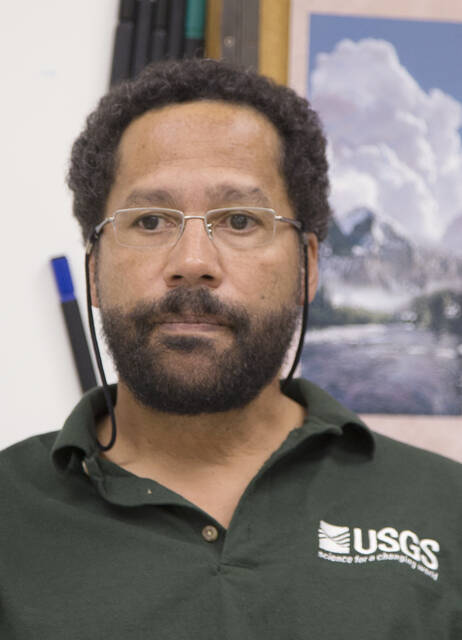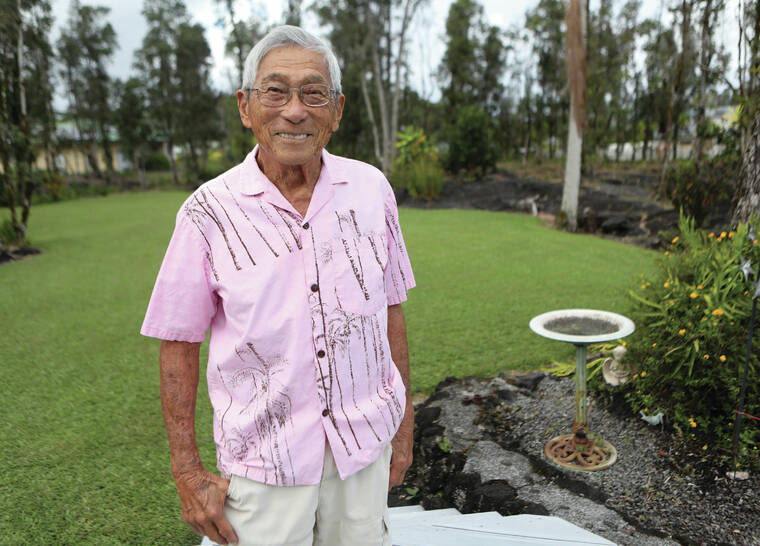Hawaiian Volcano Observatory research geologist Frank Trusdell is considered an authority on Mauna Loa.
When the Earth’s largest active volcano last emitted lava, for 22 days in March and April 1984, Trusdell was a graduate student on Oahu and had been a summer intern at HVO. He came to the Big Island two days into the eruption at the behest of the late Reggie Okamura, then HVO’s chief of operations.
“I was basically a helper. What can I say?” Trusdell, who received a Meritorious Service Award from the U.S. Department of the Interior earlier this year for his maps and studies of Hawaii volcanoes, told the Tribune-Herald on Thursday. “It was daunting then. And now? It’s still daunting, but I have years more of experience, so I’m not a deer in the headlights like I may have been then.”
The 22-day eruption more than 38 years ago sent lava from the mountain’s Northeast Rift Zone toward Hilo and Kulani Correctional Facility, then known as Kulani Prison.
“The lead up to the (current) eruption was very similar to ’84,” Trusdell said. “We have better tools now, but there’s still so much to learn. The similarities are that we’re down to a central vent now that’s become dominant, just like in ’84. It’s sending long rivers of a‘a down slope. It’s not in the same place, but it’s kind of the same morphology.
“We don’t really have a good handle on the fluxes yet, although we have some idea that they’re comparable to the kind of fluxes that happened in Pahoa in 2018 — meaning the volume of lava coming out per unit of time is comparable to that, which is also comparable to what came out in 1984, as well.”
Former Mayor Harry Kim was county Civil Defense administrator in 1984, a position he held for 24 years before becoming Hawaii County’s chief executive in 2000. In his role at Civil Defense, as well as in his dozen years as mayor, Kim has dealt with volcanoes more on a day-to-day basis than any other county official.
“I remember ’84 like it was yesterday,” Kim said. “This is the first time that Hilo was basically threatened. With the unknown comes fear. And in 1984, there was a lot of fear in Hilo people. Rumors lead to confusion, which adds to the complexity of the anxiety and fear.
“We did community meetings, putting maps out, and every-morning radio updates. We didn’t have the technology we do today. Your presentations have to let the public know that you are calm, you are in control, and you will keep them updated every single day.”
Kim was informed about the eruption in a middle-of-the-night phone call from a dispatcher, since deceased.
“We immediately went to work. And 21 days later, I went home,” he said. “Because when you have the responsibility, you carry the burden of each person looking to you for guidance.”
In 1984, the lava was heading toward Hilo as well as the minimum-security state prison on Mauna Loa’s southeast flank. The march of the molten rock eventually stopped short of both, with media reports at the time saying the Hilo-bound flow came to within four miles of the city limits.
“One of the biggest things discussed then, and it’s being said now, is ‘what will government do to divert the flow?’” Kim said. “There was a heavy discussion. Gov. (George) Ariyoshi and Mayor (Herbert) Matayoshi and a couple of his staff called a special meeting with me — and the whole discussion was ‘what was my position on diversion?’ And I’m hearing the same things today. And I heard (HVO Scientist-in-Charge) Ken Hon’s response, which was a good one.”
Hon, on Wednesday, said it would take 10 dump-truckloads per second of whatever one thought might divert or stop the lava to have even a remote chance of deterring the current flow from overrunning Daniel K. Inouye Highway, should the volcano continue its output of lava — although the a‘a flow front has slowed considerably since hitting flatter ground.
“People are speculating about which way the flows are going to go. And we don’t know yet,” said Trusdell. “Because we’re at the divide between the east and west, it depends on what happens in the next few days. The flows filling the low spots and making a directional focus will decide whether it’s (West Hawaii) or Hilo that’s going to be potentially in harm’s way.”
After two days of rain at the beginning of the 1984 eruption, the glow of lava on the mountain was visible at night from the Hilo Bayfront, as it is during the current eruption.
“The glow of the lava, the smoke — you could literally hear, in the quiet of the night, methane gas explosions from the mountain,” Kim said. “Your sense of sight, your sense of smell, and your sense of sound all combined in this lava flow to a threat headed towards you. And no matter how much you told them and laid out the maps for them, etc., etc., you know how tremendous that fear was.
“It was a 20-day tension build-up. And as soon as I had information that HVO said the eruption is over, it was a big relief to me.”
Both Trusdell and Kim said the important thing for those living down-slope of the eruption is to monitor official sources of information and to dismiss speculation.
“People should be aware that we’re tracking the situation,” Trusdell said. “And as soon as things manifest themselves, any changes in the eruption, then we will let people know.”
Kim, known for his love of nature, told a story about the 1984 eruption to drive home the same point.
“I was renting a helicopter, because that’s what we did those days, tracking where we thought it would go,” he said. “And as it was hovering, watching the front of the flow from a safe distance, I saw these two hawks keep circling. And all of a sudden, I realized why they were doing that. Their nest was probably there. And I felt the greatest sadness that baby hawks or eggs were probably going to be destroyed by this lava flow. And it’s not that I don’t care about people, but in this moment, I was talking to Pele, ‘Spare these birds, please.’
“Nobody talks much about wildlife. Right now, it’s covering old lava flows. There are no trees around. The only animals are goats and pigs, and they move fast because fire and smoke will make them go crazy. And our duty as the government — and I consider myself a part of the government, forever — is to maintain trust with the people of this island to keep us safe.
“And no one should get hurt if they listen to the official precautions.”
Email John Burnett at jburnett@hawaiitribune-herald.com.









